#Tower-Roosevelt Area
Text
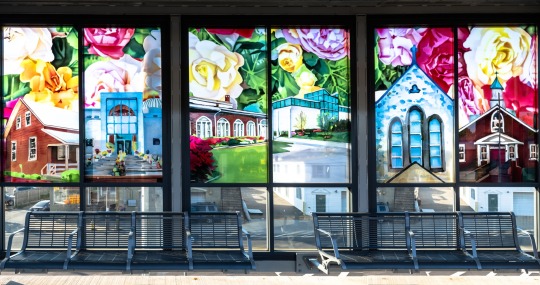
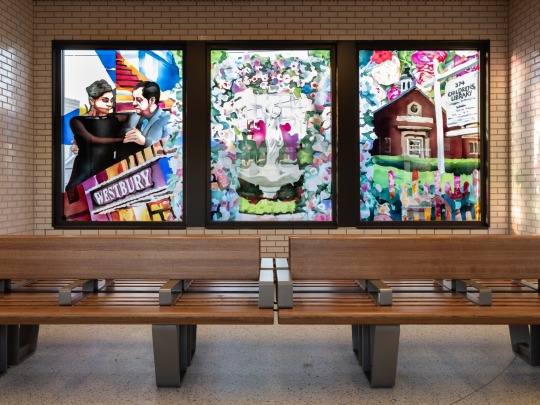

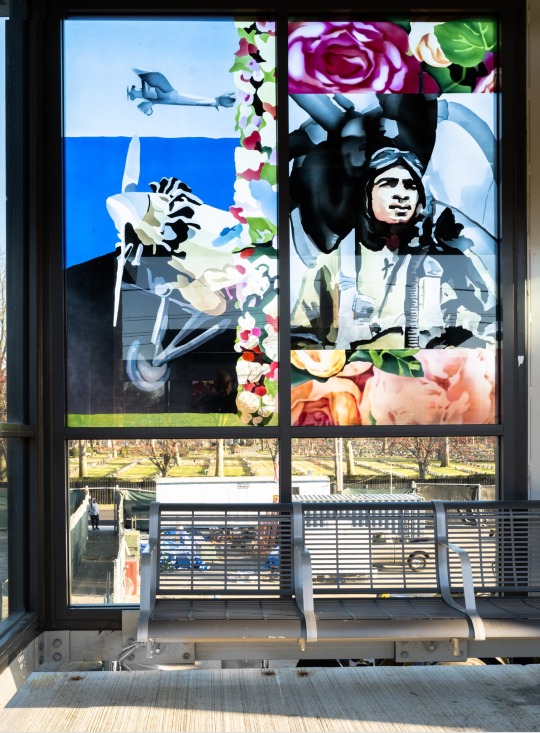
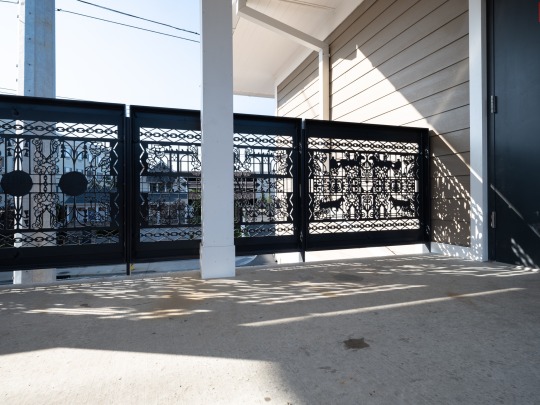
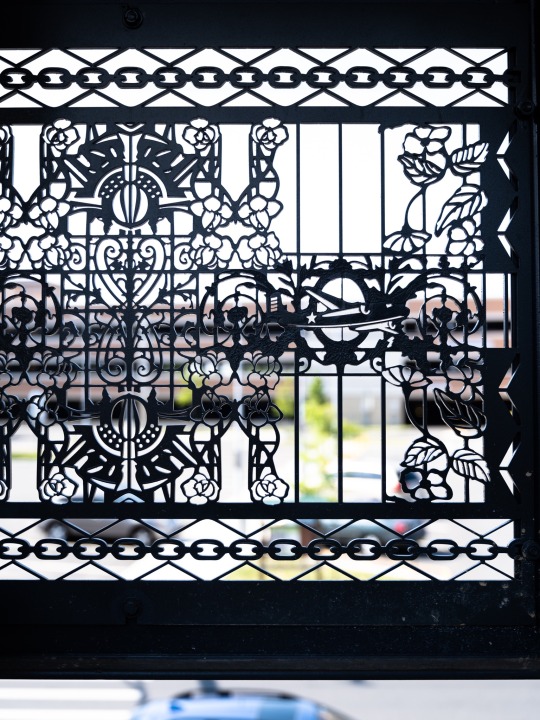
Arts & Design is excited to unveil a new permanent artwork by Darryl Westly at LIRR Westbury station. “Illuminations” (2023) is a dynamic, allegorical reflection of the people and places of Westbury that employs glass, metal, light, and shadow as equal counterparts, creating symbols of remembrance and an environment for transitory contemplation.
“Illuminations” was translated from original paintings by Westly that gather the past and present histories of the village and community, which have been translated into 782 square feet of painted glass by Glasmalerei Peters Studios, and 140 square feet of etched metal work fabricated by KC Fabrications. Spanning the station's ticket office to the overpass towers, the work blends divergent narratives, archival imagery, and motifs from Westbury’s past into brilliantly colorful dreamscapes.
The painted glass is interspersed with patterns inspired by Wampum Belt designs, juxtaposing Tuskegee Airmen, farm stands, and the local children’s library. Recurring floral and bouquet motifs reference the gardens of the historic Orchard Hill Estate, serving as metaphors for the ancestry of the land and the cultivation of community. In the etched metal railing, race cars and horses harken back to the old Roosevelt Raceway, boats reference the migration of Quakers to the area, and chain-links take on the dual meaning of both the history of enslavement and the bonds that now hold diverse communities together. “Illuminations” honors Westbury history while also leaving space to contemplate its future. It is a memorialization of moments in history where people can find meaning, understanding, and connection, regardless of race, creed, or class.
📸: Jason Mandella
20 notes
·
View notes
Text
The Auditorium Annex / Congress Plaza Hotel, Chicago - Part 2
Here are more illustrations and sources for the Congress Plaza:

Congress Hotel at night with sign

View of the hotel from Congress Plaza, Ryerson and Burnham Archive, Art Institute of Chicago
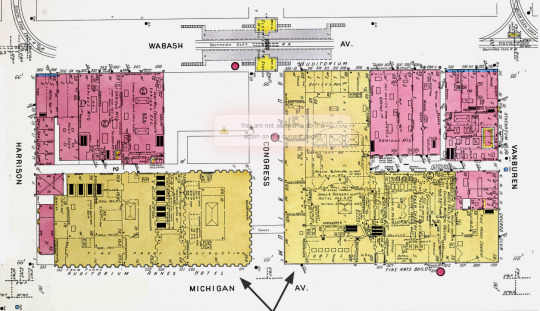
Sanborn Fire Insurance Map, 1906
Historic American Buildings Survey photos

Library pier capital, 1963
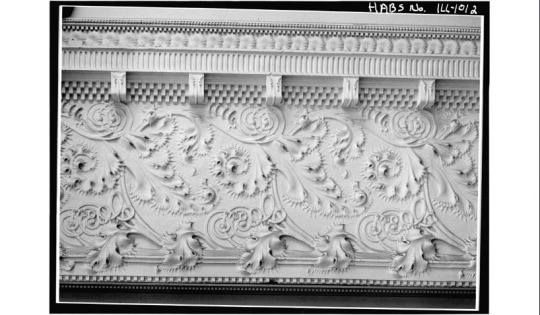
Congress Hotel frieze, 1963

Auditorium Building (right), Congress Hotel north and south towers (left), no date

Theodore Roosevelt speaking from Congress Hotel Chicago

YMCA Dinner, Gold Room, 1908
Link to the HABS historic structure report [PDF] and excerpts (below):


Floor Plans published in The Brickbuilder, January 1903 [Link here] of the Auditorium Annex:

Fifth Floor Plan, p. 31
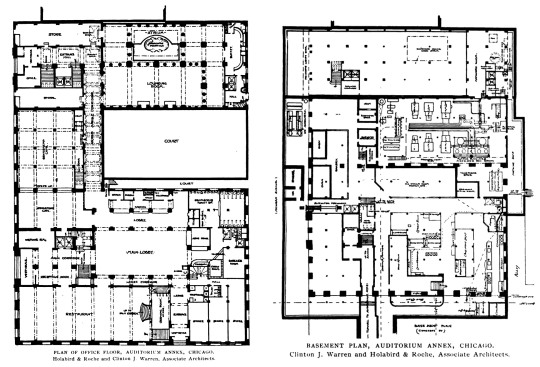
Office Floor Plan (p. 50, left) and Basement Floor Plan (p. 71, right)
Excerpt of description of the Auditorium Annex (p. 29):
...The ideal hotel would be one in which every room was provided with a bath, ample closets, a fireplace and a bay window. The hotel which comes apparently nearest answering all these requirements is the Auditorium; Annex in Chicago. Every outside room has a bay window and many of them have fireplaces, but it is seldom possible to have bays to this extent on account of restrictions of building laws and the necessity of utilizing as much of the lot area as possible....
...Then besides these extremely elaborate apartments there are usually a number of rooms arranged in groups so that they can be rented in suites, such as the front apartments of the Hotel Touraine or the rows of rooms facing Michigan Avenue in the more recently completely portion of the Auditorium Annex….
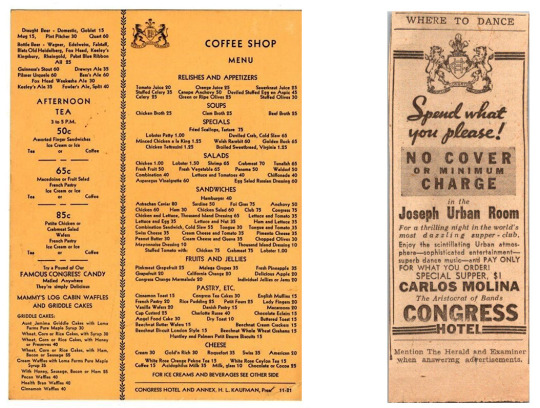
Coffee Shop Menu (left) and Joseph Urban Room newspaper ad (right)
Louis Grell, Painter
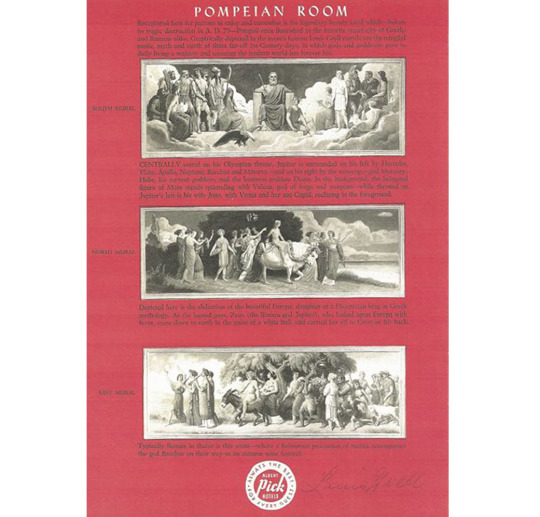
Pompeian Room Menu, signed by Grell
Louis Frederick Grell (1887-1960) was a prolific muralist and portrait painter, focusing on large-scale figure compositions. He was an art instructor at the Chicago Academy of fine Arts and at the Art Institute of Chicago. Grell would exhibit his artwork at the Art Institute 25 times. He studied briefly at the Ecole des Beaux-Arts in Paris before returning to the U.S. in 1916.
Grell resided at the Tree Studios artists' colony in Chicago from 1917 until his death in 1960. More than 75 National Historic Landmarks across America can boast his murals adorning ceilings and walls.
Grell's work at the Congress Plaza Hotel included both the Pompeian Room and hotel lobby.
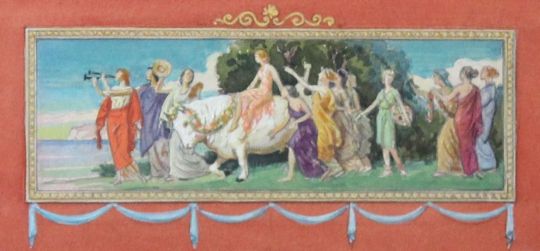
Grell, study for Europa mural, Pompeian Room
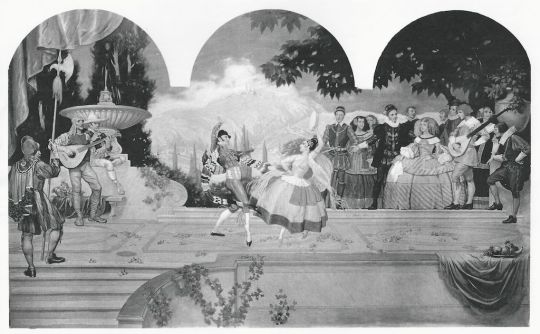
Grell, mural in the Aragon Ballroom, Chicago
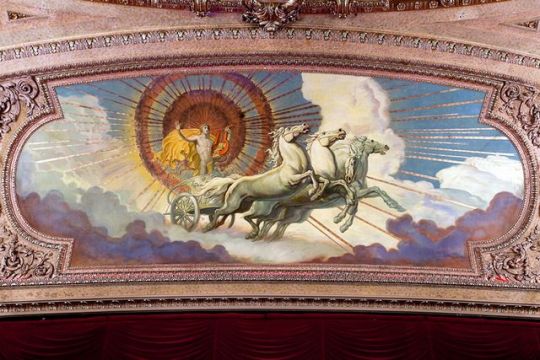
Grell, Apollo mural above the proscenium, Chicago Theater, Chicago
Information about Grell's mural for the Congress Hotel is found on the Louis Grell Foundation website here.

Grell, 12 lobby murals for the Congress Hotel, 1952

August 1952 news coverage of the new Grell murals

Postcard view of the Grell lobby murals (now replaced by mirrors)
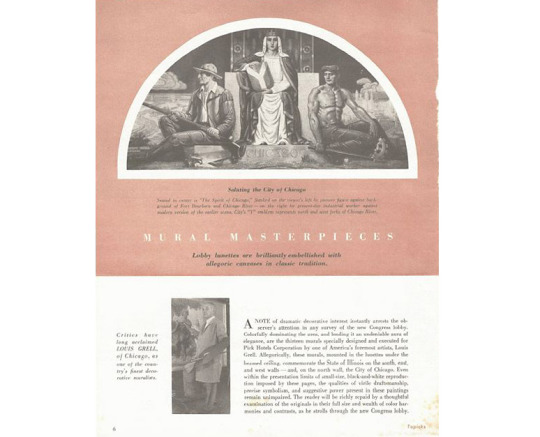
"Mural Masterpieces," no date or publication
My photos of the Congress Plaza Hotel

Hotel Lobby
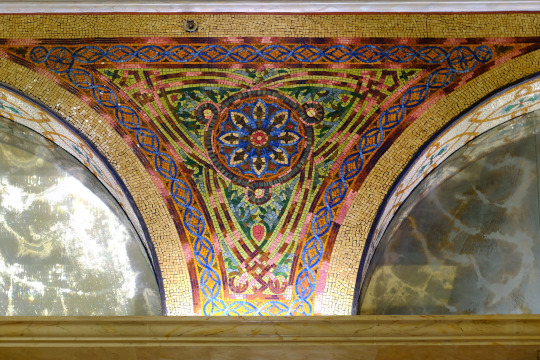
Lobby Mosaic; the textured mirrors on either side replaced (or covered over) the Louis Grell murals.
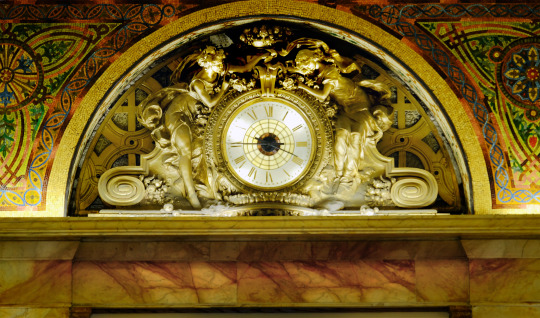
Lobby Clock

"Presidential Chair," gift of the White House to the hotel

Lobby Table and Sculpture
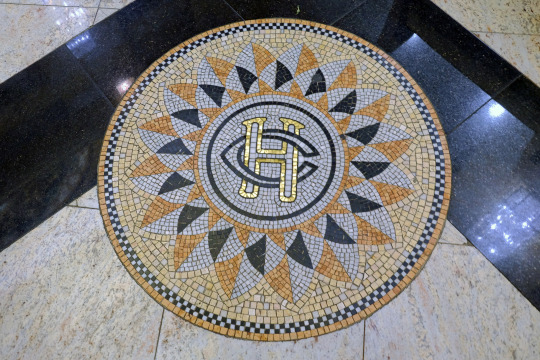
Floor Mosaic, Lobby

South Tower Elevators
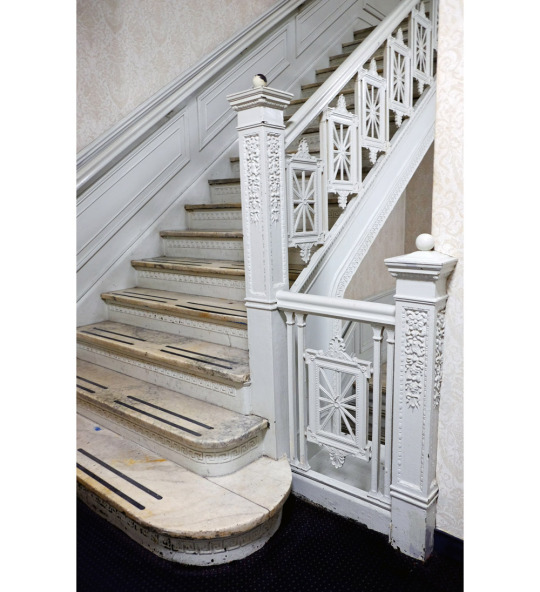
Stairway Banisters, upper floors
Next: postcard views of the hotel
3 notes
·
View notes
Text
Obviously everyone knows that I went to downtown today right so I took the sound Transit skip to 4G LTE towers on two stinky tofu robots from Washington Saigon area same locations right all the discussions that I haven't had all the tortures that I had is coming out of this f****** same locations these n***** f****
So while we were coming from downtown to you Doug it literally within 5 seconds it passed through and was at UW district I didn't even know it passed until someone said this is Roosevelt
I know about these glitches cuz it happened before where it skips lines it jumps lines it crosses over and stuff like that so those two females that were robots were communicating using avatars talking about some b******* right and then through that process they mentioned something about past experience at which they weren't ready for or was there for so during that process they got Mandela so I went up to whole foods and grab my pizza and other stuff some fish and some chicken because that's what was needed for me and for them as well to fill this void of you hitting me with infrared and being able to replenish it with something else I don't understand why I have to go through this process again especially at the time and what you know and knowingly
Just want you to know 5600 whoever NSA Pentagon DOD f*** all you guys you know exactly who I am and I will be f****** hunting for you you better f****** stop or else you will be f****** Damned
2 notes
·
View notes
Text
I just traveled round trip across the country to see Joni Mitchell in concert. Stopping at National Parks on the way there and back home. The furthest west I went was to Cannon Beach in Oregon. Saw the Haystack Rock and the Pacific Ocean for the first time, first time seeing out west too. I went to the Badlands, Yellowstone, Mount Rainier, Cannon Beach, Grand Teton, Yellowstone (again), Theodore Roosevelt, and then the Indiana Dunes Nat. Park (which was the worst, there was a huge gas plant right next door and smog and pollution filled the air).
First time experiencing such large, expansive landscapes—I mean I've seen wide open spaces before, just nothing like what I saw near Yellowstone and Mt. Rainier. On my way from South Dakota to Montana, I took Route 212, which eventually leads to the Cheyenne Reservation, but that road was barren. Hardly any population, no exits, etc. just a two-way highway with big rigs flashing passed you. If you want to pass the person in front of you, you'd better calculate it right. Apparently it's one of the most dangerous highways in America. I rode that for hours, driving across flat, spacious lands and up through the Custer Gallatin National Forest.
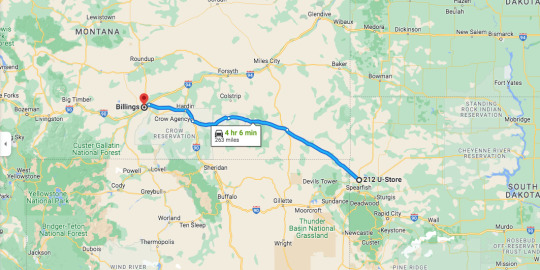
I got off 212 before Billings, MT and that's where I first came across the Yellowstone River. That night I stayed in Bozeman, MT and in the morning spontaneously decided to go to Yellowstone. From there the adventure really began. White capped Mountains came into view for the first time, nearing Bozeman. I was so emotional driving to the West entrance of Yellowstone. It was early morning and the moon was setting over this snow covered mountain range, and the sun rising over it all. You wind down this long road, along rivers and through valleys—in the thick of nature (Route 191 from Big Sky, MT to the West entrance of Yellowstone) After Yellowstone I headed for northern Idaho, then finally Quincy/George, WA area where I stayed for a few days before seeing Joni in concert.
Joni was incredible. I was expecting my mind to implode but when I saw her but I was just like, yup there's Joni Mitchell. It was natural. She was so sweet and jovial and it was just the icing on top of this unbelievable journey, that was only just beginning. Following the concert I traveled to Mount Rainier. Going through Yakima county which was desert like, until you start nearing the park area. Just near the end of Yakima county you can see the rivers are turquoise. Then the farther you get into the mountains, the lakes are bright blue, glacial blue. Mount Rainier hangs in front of you, following it deeper into the mountains. Eventually I arrived in Packwood, WA and took a back road "Skate Creek Road S" to the Nisqually entrance. That went through deep woods, following a river until you hit a stretch of road with huge trees towering over you. By the time I reached the park the morning mist had fully moved in, blanketing Mt. Rainier.
From there I went to Cannon Beach in Oregon to see the Haystack rock. That was beautiful and magical. Then crossed Oregon, then Idaho where I reached Ammon, ID. I was going to have an early end to travel day, so I decided to go see "Across the Spider-Verse" but when I reached the area a storm moved in and torrential rain poured down. Ponding started happening, then all of the traffic seized and the side road I was suppose to go down was closed. I eventually made it to the theater, but you could here the pound of the storm from within. I was full of anxiety until the movie ended and I came out to sunshine and relief. A lot more happened but i'll leave this here. I had fun. ☺︎
#Joni Mitchell#Me#Refuge of the Roads#Travelogue#Music#Cross Country#Road Trip#National Parks#Yellowstone#Mount Rainier#Grand Teton#Cannon Beach#Haystack Rock#Gorge Amphitheater#Theodore Roosevelt National Park#Route 212#Badlands#Washington#Oregon#Idaho#Wyoming#Montana#South Dakota#North Dakota
4 notes
·
View notes
Photo










Colorado National Monument (No. 21)
President Teddy Roosevelt used the power given to him in the Antiquities Act of 1906 to declare Devils Tower in Wyoming the first national monument. He thought Congress was moving too slowly and it would be ruined by the time they made it a national park. John Otto, the Colorado National Monument’s first caretaker, watched Roosevelt's actions closely. He, too, believed Congress acted too slowly to protect our nation's treasures, so he kept pushing for action to protect the magnificent canyons forming the southwestern border of Grand Junction. Finally, in May 1911, Otto got his wish thanks to a decree from President Taft, and the Colorado National Monument was born.
To enjoy the Colorado National Monument, you must pay a fee to enter the area. The annual entrance pass fee for Colorado National Monument is $45. Seven-day entrance passes are $25 for a private, non-commercial vehicle, $20 for a motorcycle, and $15 for an individual (hiker or bicyclist). Passholders with the America the Beautiful - National Parks and Federal Recreational Lands Annual Pass will be able to enter the Colorado National Monument with that.
You can also pay at the Visitor Center. The Colorado National Monument Association (CNMA) runs the bookstore at the Visitor Center. CNMA is a nonprofit organization whose mission is to assist the National Park Service with scientific, educational, historical and interpretive activities at Colorado National Monument.
CNMA produces a useful Alcove Nature Trail Guided Tour brochure, available at the trailhead or in the Visitor Center for only 50 cents. Use the brochure to sound like an expert when you take others on this scenic 16-mile drive over the Colorado National Monument.
Discover that the red color of the Entrada sandstone comes from iron oxide, just like rust on a piece of metal. This layer of sandstone is very old and was formed between 95 million and 195 million years ago. Learn about the single-leaf ash, Kayenta sandstone, rabbitbrush, dark, lumpy microbiotic crust, sagebrush, and pinyon pine as you explore the diverse beauty of the Colorado National Monument.
Source
#Colorado National Monument#Colorado#Independence Monument#USA#travel#summer 2022#Mountain West Region#red rock#Colorado Plateau#rock formation#Book Cliffs#tourist attraction#landmark#flora#nature#view#bush#tree#blue sky#clouds#original photography#Rim Rock Drive#landscape#countryside#desert#geology#vacation#road trip
3 notes
·
View notes
Text
Discover Olympic National Park Guide 2024
Olympic National Park, located on the Olympic Peninsula in Washington State, is renowned for its remarkable diversity in ecosystems, ranging from temperate rainforests to alpine regions and rugged coastlines. This variety makes it a fascinating destination for nature lovers and adventure seekers. Here’s an overview of what you can discover in Olympic National Park:

Ecosystems and Landscapes
Temperate Rainforests:
Hoh Rainforest: One of the most famous temperate rainforests in the world, the Hoh Rainforest is characterized by lush, green vegetation, towering trees covered in moss, and abundant rainfall.
Quinault Rainforest: Another temperate rainforest within the park, known for its old-growth trees, including Douglas fir and western red cedar.
Alpine Regions:
Hurricane Ridge: Offers stunning panoramic views of the Olympic Mountains and opportunities for hiking, skiing, and snowboarding.
Mount Olympus: The highest peak in the park, offering challenging climbs and spectacular glacial scenery.
Coastal Areas:
Rialto Beach and Ruby Beach: Famous for their sea stacks, tide pools, and dramatic coastal landscapes.
Ozette Loop: A popular trail that takes hikers through coastal forests and along scenic beaches.
Forests and Meadows:
Elwha Valley: Known for its restoration efforts, particularly the removal of the Elwha and Glines Canyon dams, which has allowed the river to return to its natural state.
Sol Duc Valley: Features hot springs, waterfalls, and dense forest trails.
Wildlife
Mammals:
Roosevelt Elk: The park is home to one of the largest herds of Roosevelt elk in the Pacific Northwest.
Black Bears: Frequently seen in the park, especially in the forested and meadow areas.
Mountain Goats: Often spotted in the alpine regions, particularly around Hurricane Ridge.
Birds:
Northern Spotted Owl: An endangered species that finds habitat in the park’s old-growth forests.
Bald Eagles: Commonly seen along the coast and near lakes and rivers.
Marbled Murrelets: A seabird that nests in the park’s ancient trees.
Marine Life:
Sea Otters: Often observed along the coast, especially in the kelp beds.
Gray Whales: Migrate along the park’s coastline, particularly visible during migration seasons.

Activities
Hiking: Olympic National Park offers a vast network of trails catering to all levels, from short walks to multi-day backpacking trips.
Hoh River Trail: A popular route that takes hikers deep into the rainforest.
Seven Lakes Basin: A challenging but rewarding hike offering alpine views and pristine lakes.
Camping: Numerous campgrounds are available, ranging from drive-in sites to backcountry camping.
Kalaloch Campground: Located on the coast with stunning ocean views.
Deer Park Campground: Offers high elevation and panoramic mountain views.
Water Activities: The park's rivers, lakes, and coastline provide ample opportunities for kayaking, fishing, and swimming.
Lake Crescent: A beautiful, clear glacial lake ideal for kayaking and swimming.
Sol Duc Hot Springs: Offers a relaxing soak in natural hot springs.
Wildlife Watching: Best done during early mornings or late evenings when animals are most active.
Tide Pooling: The park’s coastal areas are perfect for exploring tide pools teeming with marine life.
Conservation Efforts
Olympic National Park is committed to preserving its diverse ecosystems and wildlife. Efforts include habitat restoration, invasive species control, and monitoring of endangered species. The park also focuses on educating visitors about Leave No Trace principles to minimize human impact on the environment.
Best Times to Visit
Summer (June to September): Offers the most accessible weather for hiking, camping, and other outdoor activities.
Spring and Fall: These seasons provide fewer crowds and unique opportunities for wildlife viewing and experiencing the park’s changing landscapes.
Winter: While some areas may be less accessible, Hurricane Ridge offers winter sports and spectacular snowy vistas.
Visiting Olympic National Park provides a unique opportunity to experience one of the most diverse and pristine natural areas in the United States. Whether you are interested in hiking through ancient forests, exploring rugged coastlines, or observing a wide variety of wildlife, the park offers something for everyone.
READ MORE AT: https://nationalparkshops.com/olympic-national-park-2/
0 notes
Text
Disney day!
We got to Disney a little after open and wow it was packed! Absolute madness. Japanese at Disney go hard!! Everyone was decked out in full gear, buying so much shit. We’re talking hats, shirts, toys, pins, towels. People dropped cash 🤑🤑 so naturally we had to as well. We purchased our first hats of the day, me- dark blue velvet ears, Thomas- a Baymax plushy head. Excellent choices. Tokyo Disney had a great app that shows ride waits in real time. You can also book shows, restaurant reservations and more on there.
The park is centered around a giant lake which the different sections branching off of that. A massive volcano sits atop the lake which goes off intermittently. The park is broken into an Italian section, the American waterfront, the little mermaids grotto, Agrabah, and the volcano area which also houses 20,000 leagues under the sea in it so has a cool old steampunk look to it.
Instead of doing an all day fast pass you can now pay individually for specific rides. The priority pass would range from $6-$13 depending on the ride. We didn’t mind paying bc entry into the park was only $54, wayyyy cheaper than American so a few more bucks to cut the line wasn’t a big deal. I heard lines can get crazy long so we jumped on that and booked a priority pass for Toy Story. While we waited for it to start, we explored the Venetian side of the park. It was gorgeous, truly made you feel like you are in Italy. We took a gondola ride and now I’ve ridden a gondola in Las Vegas and Japan lol! Disney is fun because vendors sell items or food that are only at that stand. So if you see something, buy it! Which we did with all the food we saw. Everything was seriously top notch. We kept seeing people eating popcorn out of speciality buckets- a Pooh Bear honey pot, a monsters inc one. And hella lines for the popcorn. Turns out they all sell different flavors of popcorn and sell different novelty buckets. We did pass on this, too much other food to snack on. We headed to the American waterfront where Toy Story is housed and cut the line with our priority pass. You are instantly transported to Andy’s room, where everything is gigantic. The ride is a 3D shooting ride where you compete against your partner to hit the most targets on the room. Thomas smoked me.
Next up was Tower of Terror which Thomas was not thrilled for but I was stoked! Again we got a priority pass and cut the line (so worth it) and it was a thrill. The waiting areas for all these rides are so detailed and done up. Really adds to the experience.
Next we wandered over to the volcano area and explored the fortress that was there. Lots of nooks and crannies with different things hidden inside of them. Thomas ate his first turkey leg! The cannons were pop guns where you pulled a cord to fire and smoke came out. Then we went over to do the Journey to the Center of the Earth ride. This area was amazing! All steam punk and brass. We ate an incredible long gyoza dumpling and the ride was super fun.
They had a shop full of Baymax stuff. Next we cross over to 10k leagues under the sea. You ride on a “submarine” and it was neat. After we walked over through the Mermaid side of the park which honestly might have been my favorite. It was for little kids but the most intricate and beautiful. There were so many little details to look at and take in. After that we wandered to Discovery Park which is a futuristic science park. We got shrunk down to Nemo’s size in a fish boat and then also rode a bumper boat trip of ride that was very fun.
After we had a tasty sushi roll with chicken and shrimp and took the train back to American Bay and had lunch at Sakura. It was a traditional Japanese box with fish and rice and cold udon. After we went over to the giant cruise ship which had a Teddy Roosevelt bar. I (Thomas) stayed there and had a few drinks in the wood paneled bar while Meag went and watched a show. The show was the midday parade, but at this park it’s done on boats on the big lake. Very funny to hear Japanese Minnie and Mickey. Then we met up and rode a little roller coaster ride. It had a loop! I’ve never been upside down.
After that we got tiny alien dumplings and queued up as single riders for Indiana Jones ride which was also amazing. We wandered back to the main area after that for a little snack and to watch the light show. Meag got spaghetti and meatballs and the light show was great. They come out on so many boats. A lot of the signing was Japanese and they circled an enormous light tower. They even projected things onto the volcano! It was great. When that finished we heard they cancelled the firework show 😭so we headed home tired and happy.
It was such a cool cool day. Very happy we checked it out!
0 notes
Text
The Great Outdoors: Camping and Outdoor Recreation Near Phoenix

When immersing oneself in the great outdoors, Phoenix, Arizona, is an ideal gateway to various camping and outdoor recreation experiences. From tranquil desert landscapes to lush mountain retreats, here's a guide to outdoor havens that promise adventure and relaxation.
1. Tonto National Forest: A Wilderness Escape
Tonto National Forest, located just northeast of Phoenix, is a sprawling expanse that offers a diverse range of camping experiences. Whether you prefer lakeside camping at Roosevelt Lake or the solitude of the Apache Trail dispersed camping areas, Tonto National Forest provides a serene backdrop for reconnecting with nature.
2. McDowell Mountain Regional Park: Desert Oasis
McDowell Mountain Regional Park is an excellent choice for those seeking a desert escape with panoramic views. Campsites are nestled against the backdrop of the McDowell Mountains, offering hiking and mountain biking trails for daytime adventures. As night falls, the clear desert skies provide a breathtaking canvas for stargazing.
3. Lost Dutchman State Park: Legends and Campfires
Named after the fabled Lost Dutchman's Gold Mine, this state park offers a blend of history and outdoor recreation. Campers can set up beneath the iconic Superstition Mountains and explore trails that wind through the Sonoran Desert. As evening descends, gather around a campfire and immerse yourself in the rich tales of the Lost Dutchman legend.
4. White Tank Mountain Regional Park: Desert Beauty and Petroglyphs
White Tank Mountain Regional Park, known for its ancient petroglyphs and rugged beauty, is a haven for outdoor enthusiasts. Campers can choose from campsites surrounded by saguaro cacti and picturesque desert landscapes. The park's extensive trail system invites exploration, and the Waterfall Canyon Trail is a must-visit for a refreshing outdoor adventure.
5. Lake Pleasant Regional Park: Lakeside Serenity
Lake Pleasant Regional Park offers a camping experience with a waterfront view. With numerous campgrounds dotting the shoreline, campers can enjoy water activities during the day, from boating to fishing. The desert sunsets reflected on the lake create a magical atmosphere, perfect for unwinding around the campfire.
6. Usery Mountain Regional Park: Hiking and Desert Flora
Usery Mountain Regional Park is a hidden gem offering a diverse landscape of desert flora and mountainous terrain. Campers can choose sites surrounded by the unique beauty of the Usery Mountains. The park's extensive trail system caters to hikers of all levels, providing an opportunity to witness the desert's vibrant plant life up close.
7. Payson: A Mountain Escape
Venture northeast of Phoenix to the town of Payson for a mountain retreat. Surrounded by the Tonto National Forest, Payson offers campgrounds amidst towering pine trees. Escape the desert heat and enjoy a cooler climate, with ample opportunities for hiking, fishing, and simply basking in the tranquility of the forest.
In conclusion, Phoenix and its surrounding areas provide a tapestry of outdoor experiences, from the vastness of the desert to the calm serenity of mountain retreats. Whether you're a seasoned camper or a novice outdoor enthusiast, these destinations offer a chance to disconnect from the hustle and bustle, embrace nature, and create lasting memories under the Arizona sky.
0 notes
Text
On the Brink of War!




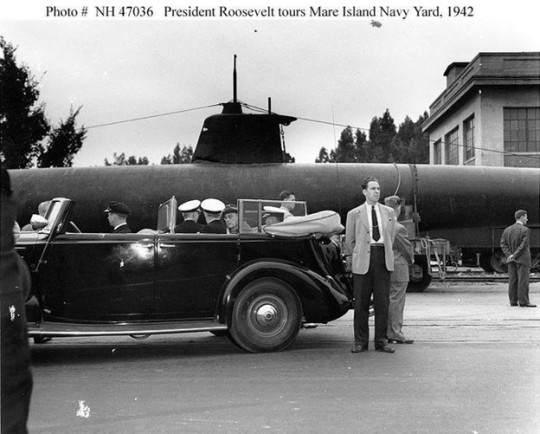

Early on the morning of 7 December 1941 a Mare Island built ship was just off the mouth of the entrance to Pearl Harbor. While the world was at war, the United States was at peace and the crew of the USS Ward (DD 139) undoubtedly anticipated another quiet sunrise in tropical paradise, but that was not to be. The morning proved surreal as crew members were suddenly engaged in a life and death struggle that presaged the massive aerial assault that was about to unfold. That crew drew first blood against the surprise Japanese onslaught on Pearl Harbor. Unlike the rest of Pearl Harbor’s defense forces, the Captain and crew of this warship were not caught sleeping.
The Ward, under the command of LCDR William W. Outerbridge, was conducting a precautionary patrol off the entrance to Pearl Harbor. This was his first command and his first day in command. Then at 03:57, he was informed by visual signals from the coastal minesweeper USS Condor of a submarine periscope sighting within the "Defensive Sea Area." Submarines were required to travel surfaced in that area, but this one was mostly submerged. Ward began searching for the contact and several hours later Ward's lookout spotted the conning tower of a midget submarine. By then the destroyer had increased its speed to 20 knots and range was down to 100 yards. The Ward opened fire with a 4” round. The Ward was now steaming at more than 22 knots and, as she closed to 50 yards, the gunners fired a second 4-inch shell almost straight down at the sub’s conning tower. The shell struck the base of the midget submarine's conning tower blowing a 4” hole through its port side. This explosive shell is thought to have instantly killed both crewmembers. Ward continued over the submarine’s bow, which bounced around and floundered for a few seconds then sank out of sight. Capt. Outerbridge swung his ship hard around and ordered four depth charges to be dropped on the spot where the sub was last seen. Six minutes after opening fire on the sub, at 06:51, Captain Outerbridge signaled 14th Naval District Headquarters:
“WE HAVE ATTACKED FIRED UPON AND DROPPED DEPTH CHARGES UPON SUBMARINE OPERATING IN DEFENSIVE SEA AREA.”
Unfortunately, that warning did not cause the island's defense forces to go on alert, nor would the newly installed radar operators report nearly an hour later:
"LARGE NUMBER OF PLANES COMING IN FROM THE NORTH, THREE POINTS EAST."
The operator taking that report passed on the information repeating that the operator emphasized he had never seen anything like it, and it was:
"AN AWFUL BIG FLIGHT."
Of course, we now know that flight was the first wave of the Japanese aerial attack and at 07:45 the attackers achieved complete surprise. In addition to the success of the aerial attack, two of five Japanese midget submarines made it into Pearl Harbor, and one is believed to have fired a torpedo that struck the USS Oklahoma (BB-37) which then turned turtle and sank. The next day President Roosevelt would declare "I ask that the Congress declare that since the unprovoked and dastardly attack by Japan on Sunday, December 7, 1941, a state of war has existed between the United States and the Japanese Empire." America was engaged in what was the bloodiest war in world history. Ward was built at Mare Island in a still unbroken record of 17 days. Under the pressure of an urgent World War need for destroyers; her construction was pushed rapidly from keel-laying on 15 May 1918 to launching on 1 June and commissioning on 24 July 1918. While she was built too late to contribute to WWI, she performed admirably in the first encounter with the enemy of World War II. Her sinking of the Japanese submarine was not credited for years, but then in 2009 the submarine was located by researchers from the University of Hawaii. It was found 1200 ft down off the entrance to Pearl Harbor with a visible shell hole at the base of the conning tower just as LCDR Outerbridge reported 68 years before.
#mare island#naval history#san francisco bay#us navy#vallejo#Ward#Destroyer#Pearl Harbor#world war 2#world war ii#world war two#Japanese#submarine#december 7
0 notes
Text
2024 will bring us incredible tales of Detroit's progress.

Exciting initiatives are underway in Riverfront, New Center, and downtown as of the New Year. Seeing these tales will give you a better understanding of how the city will grow in the future. Here are some tales of Detroit so book your direct low-fare flights to Detroit and enjoy with your loved one.
Michigan Central
Once a symbol of Detroit's collapse, Ford is currently renovating the Michigan Central train station. The Book Depository, Southwest Greenway, Bagley parking structure, and Roosevelt Park are among the new locations that have opened up nearby. The resurgence of the rail station will be a world story.
Momentum in Transit
Qline operations are anticipated to be taken over by the RTA, which may also finance expansions. Oakland County has seen significant bus growth, and the People Mover is investing in new trains. Positive signs in an area dependent on cars: Bus Rapid Transit may soon be available along Jefferson Avenue in Detroit. More effective transit choices in the area may result from this shift in momentum.
The West Riverfront
With the launch of the Residences at Water Square and the development of the Ralph C. Wilson Centennial Park, the Detroit Riverfront Conservancy is altering the area between Huntington Place and Rosa Parks Boulevard. These projects are a component of the Detroit Riverfront Conservancy's initiatives to restore the Riverfront and build a more dynamic, long-lasting neighborhood.
Broadway & Greektown
The Merchants Building will become a new hotel, while Bedrock will renovate the Harvard Square Centre into apartments and retail space. These developments will bring about considerable changes to the Grand River neighborhood. The alteration will unite three buildings in the center of the block with a new nine-story skyscraper utilizing a new facade and facade restorations.
Greektown is a nearby community that the state has committed $20 million to enhance pedestrian experience in the summer. This includes permitting one lane of traffic for cars and making it simpler to host festivals. Greektown is also undergoing a large $122 million development.
New Center's Henry Ford project
The Future of Health plan in New Center is being developed by Henry Ford Health in collaboration with MSU, Tom Gores, and the Pistons. A new hospital tower, medical facility, residences, open space, and parking are all part of the project. The medical research center and hospital tower are anticipated to start building in 2024, with residential construction to follow in the years that follow. Make travel plans to this wonderful city of Detroit, get cheap flights to Detroit, and spend your time here!
0 notes
Text
Mystery Lights in Estill County
The first time I'd ever heard anything about "mountain ghost lights" in Kentucky was in the early 1980s, when I dated a girl who told me the story of a large floating lights that appear and disappear on several different mountains in Estill County.
I have a lot of kinfolk in the deep-rural area and spent a good chunk of my childhood in this peculiar and spooky place. I thought I'd experienced all there was to experience there but had never heard of this phenomenon. Intrigued by the concept, I fired up the video camera and set about arranging some camping trips in the area so my girlfriend could show me these mystery lights.
The problem-or the charm, if you enjoy tall tales-with mystery lights is that when you do see a weird light on a mountain in front of you, you have no way of immediately verifying anything. I learned this the hard way when I spotted a suspicious light for the first time and started trudging up the hill like Teddy Roosevelt. Of course, I lost sight of the light when I started climbing, and when I finally got to the top, I found nothing. When I slogged my way back to camp, my lady friend reported the light had gone out just as I'd started going up. After that unnecessary exercise, I chose to simply watch and wonder from out vantage point instead of going after the answers.
After a summer of trying, we never did conceive proof of a genuine "ghost light" sighting. I chalked it up to a rural legend and filed the case in that very small section in my mind reserved for things I considered debunked. But the story of this ghost light wouldn't go out. A decade later, while I discussed paranormal matters with a retired gentleman at a flea market in Ravenna, he brought up the mystery lights with no prompting from me. His story placed the lights in Cobb Hill, a totally different area than the one to which my friend had led me. According to him, these lights weren't just stationary or floating, they were darting all around the surface of the mountain like, in his own words, "a hundred pound lightnin' bug."
This leads me to suspect some sort of electromagnetic phenomenon, rather than ghosts or UFOs, but that ain't bad. I have long suspected that some sort of ley lines type of strange energy runs through Estill County, and this could be the first step toward demonstrating that in some palpable way.
I recently spent several nights trying once again to document this phenomenon, to no avail. Because it's such a remote area, there aren't a whole lot of locals with doors to knock on and ask, but I have spoken to others who have indeed heard the rumors of ghost lights, none of whom would go on record as having actually seen them in person. I am determined to not only photograph it, but figure it out. Weird Kentucky will keep you posted.
Sand Mountain's Ghost Lights
Sand Mountain is a towering section of knobbed hills that joins the national forestland of the state. It lies about twelve miles south of Mount Sterling, and is located between the towns of Jeffersonville and Means.
In the early 1900s, before the wide use of automobiles, people in the region near Sand Mountain reported seeing mysterious lights on the steep slopes. Firsthand accounts often claim the lights appeared along the roads and paths of the mountain. They sometimes seemed to follow passing travelers, as if they had an intelligence of their own. One man claimed a ghost light often appeared along a certain stretch of road, hovered in the air, and then vanished.
As the area near Sand Mountain has grown more populated, sightings of the ghost lights decreased. Some have suggested that natural-gas wells may have caused the phenomena but no one really knows for sure. -Troy Taylor
0 notes
Text
A Comprehensive Hiking Guide to Tower-Roosevelt Area, Yellowstone National Park
Embark on an unforgettable adventure through the natural wonder of the Tower-Roosevelt Area, a hidden gem in Yellowstone National Park. With this illuminating and comprehensive guide, you’ll discover the mesmerizing beauty of its diverse landscapes, rich wildlife, and awe-inspiring vistas. We’ve got you covered, from trail descriptions to safety tips, ensuring your hiking experience is nothing…
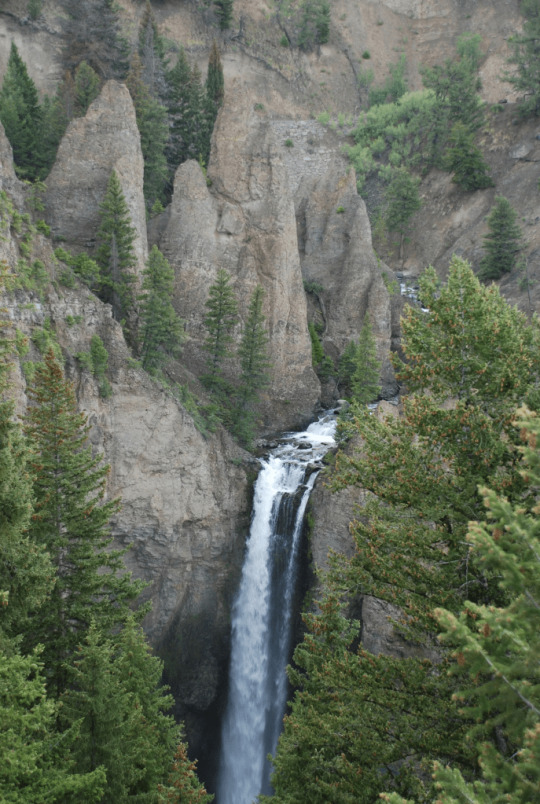
View On WordPress
#Adventure Travel#Backpacking#camping in Yellowstone#Eco-Tourism#exercise and fitness#Hiking essentials#hiking gear#hiking guide#hiking in Yellowstone#hiking tips#hiking trails#National Park hikes#natural beauty#nature exploration#nature photography#outdoor adventure#outdoor fitness#park exploration#safety tips#Scenic Views#Tower-Roosevelt Area#Trail Descriptions#Travel Guide#unforgettable adventure#wilderness adventure#wilderness survival#Wildlife Spotting#wildlife viewing#Yellowstone National Park
0 notes
Text

Schlitz park, complete with 250 gas lights, was one of the city's most popular outdoor beer gardens in the gay nineties. Located on 8th and Walnut sts., where Roosevelt junior high school and Carver park now stand, Schlitz park was popular for old and young alike. Seen above is the entryway, framing the pagoda styled lookout tower. From this four story tower in the center of the park, almost the whole city could be seen. The north end of the park was dominated by a large pavilion, open on three sides, which could seat several hundred concert and opera patrons. The open sides allowed many more to hear the frequent performances while sipping beer. The south end of the park included a dance hall, bowling alley and refreshment stands, where a schooner of beer could be purchased for 5c. Facilities in the park were available for both winter and summer parties. Two large fountains also decorated the area where many picnics and parties were held. Before becoming Schlitz park, the area was known as Quentin’s park. (Picture courtesy of Atty. and Mrs. N. G. Ewens, and information from the Milwaukee public library’s local history collection.)
0 notes
Text
Busy Pursuing Happiness in North Dakota



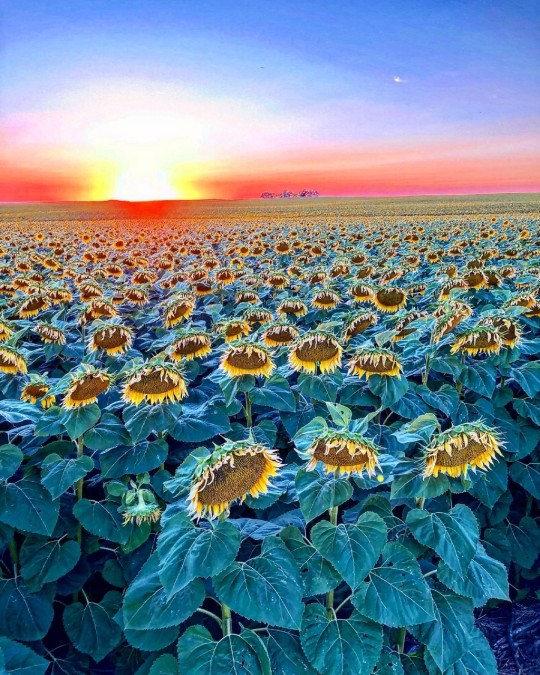


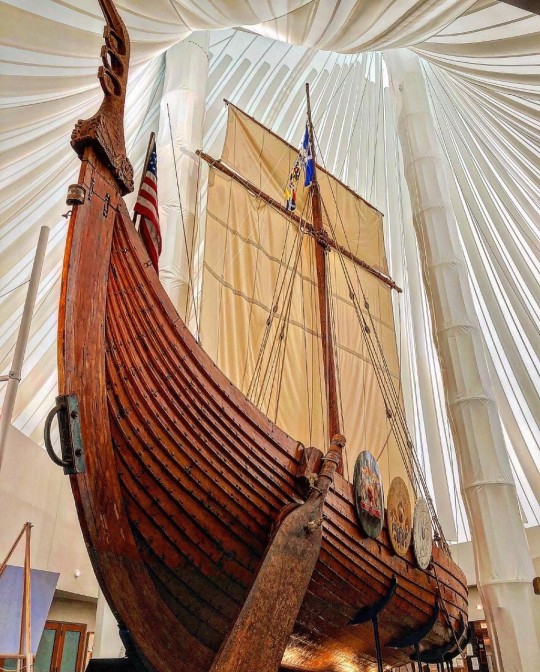
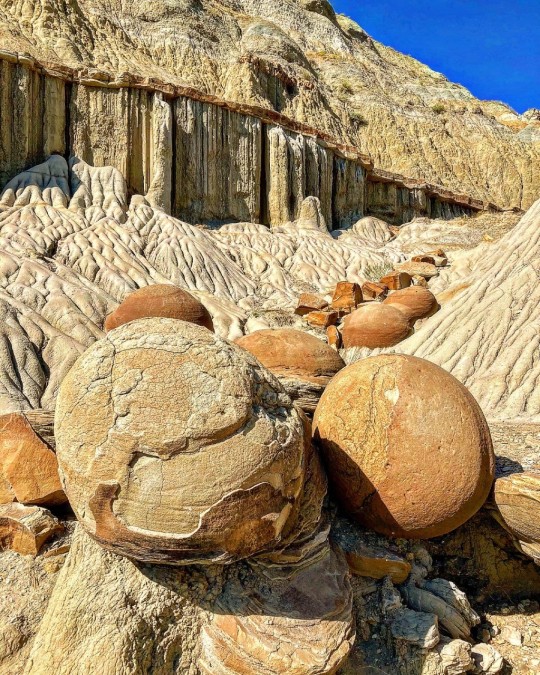


By Anders Tornsø Jørgensen
As part of my recent trip out West, I visited a lot of national parks, which I found quite fascinating. One of the founding fathers in the American nature conservation movement was President Theodore Roosevelt, and he was deeply influenced by his experiences with hunting and ranching in what would later be North Dakota. In order to pay my respect for this great president, I decided to visit North Dakota, but also to explore a state which has, and is still, deeply impacted by both Scandinavian and German immigrants. Often described as America’s least visited state, my trip to North Dakota was actually one of my most interesting experiences in the United States.
My North Dakota adventure started with a visit to Bismarck, the state’s capital. The name is by no chance random. It was named after Otto von Bismarck in order to attract German immigrants, and tickets could be bought Bremen-to-Bismarck direct back in the day.
Along with a lot of other Midwestern states, North Dakota was actually a chief beacon of progressivism in the United States. The fascinating political history of North Dakota is closely intertwined with the history of the Non-Partisan League, which had its origins in the Socialist Party of North Dakota, and was formed to protect farmers against financial institutions and big business in Minneapolis and Chicago.
This peculiar protest movement was established in 1915, and quickly found roots and life in the Midwestern soil, spreading to neighboring states. Born as a movement of agrarian protest, the Non-Partisan League led to the creation of the nation’s only state-owned bank and state-owned milling facility, both still going strong today and remains very popular among North Dakotans. North Dakota Mill and Elevator is still the largest flour mill in the U.S and most of its profits go into the state’s general fund, while the Bank of North Dakota is still the nation’s only state-owned bank with a mission of prioritizing public access over profit.
The movement also led to the establishment of a highly developed system of farm insurances, anti-corporate laws, graduated income tax, and workmen's compensation. In many ways, it was a precursor of the New Deal, which came along a quarter of a century later. Inner splintering and the fact that it later became irrelevant due to the New Deal meant that the movement lost its influence, just to mention two important reasons of its decline. And the rest is history, I guess.
Anyway, my mission was to visit the state capital building, a 21-story Art Deco tower in Bismarck, where I started my North Dakota journey. Surrounded by green areas and North Dakota monuments, the beautiful North Dakota State Capital is designed with respect for the prairie. I was greeted by a tour guide with a Scandinavian surname, and she told me passionately about the building’s details, such as how the chandeliers inside represents heads of wheat, and how the bronze elevators depict farmers and workers. Built in the 1930s after a fire burned down the old one, the architects decided to construct a tower-style capitol instead of a dome, which is more dominant among U.S. state capitols. However, towers are way more efficient when it comes to space. Only three other state capitols are tower-styled: Florida, Louisiana, and Nebraska. Among capital aficionados, tower-styled capitols are still pretty controversial and they generate a lot of debate on various web forums. I am not sure which camp I belong to – I guess I just love the art deco architecture, which the North Dakota State Capitol is a very fine example of. The building also features a long hall with Theodore Roosevelt Rough Rider Award recipients, which is the highest award given to those who have influenced the state – a reflection of Roosevelt’s impact of the state.
We’ll stay with Roosevelt for a little longer. After a magnificent tour of the state capital, I went to Theodore Roosevelt National Park, the only national park named after a person. You may also remember him from “Night at the Museum,” where Robin Williams plays a wax model of him.
Roosevelt first visited the Dakota Territory in 1883 at the age of 24, but returned a year later when the tragic loss of his wife and mother on Valentine’s Day drove him back into the lonely wilderness. Here he felt that he could mourn his tremendous loss. The area had a profound effect on his life and gave him inspiration. “I never would have been President if it had not been for my experience in North Dakota,” Roosevelt later stated.
The national park is split into three separate areas of the Little Missouri Badlands. The North Unit, the South Unit, and the Elkhorn Ranch Unit, which preserves the remains of Roosevelt’s home ranch.
I started with a drive around the South Unit’s scenic drive, where I did some hiking and enjoyed the beautiful buffalos roaming around. I also saw these impressive creatures in Yellowstone National Park, and they’re becoming my all-time favorite animal here in the United States. A park ranger told me that that buffalos roughly spends 9-11 hours a day foraging for grasses, weeds, and leafy plants. They may appear slow because of their movements, but can actually easily outrun humans, and will attack if provoked, so you better respect these magnificent creatures.
After spending time in the South Unit, I drove about an hour to get to the North Unit, which is my personal favorite part of the park. The North Unit is only about half the size of the South Unit and many people often decides to skip it, but I found it way more interesting. The coolest part was the cannonball concretions, which can easily be accessed in the North Unit. These unusual geologic formations truly look like something from another planet. Also, a hike around the River Bend Overlook offers views of the badlands – views that made me feel so wonderfully small.
Next stop was Minot, which is the home to Norsk Høstfest, North America's largest Scandinavian festival. Allegedly, 40% of Minot’s population is of Scandinavian heritage. It’s a heritage the city keeps alive at the Scandinavian Heritage Park. The park is jam-packed with slices of Scandinavian culture by having different remembrances and replicas from each of the Scandinavian countries, such as a Dala horse, a stave church replica, a sauna, a windmill, Leif Erikson, and of course H.C. Andersen, just to mention a few. The Gol Stave Church made a big impression on me. It’s a full-size replica of the original Norwegian church, which has been dendrochronologically dated to been built around 1157-1216, but the replica sure felt as real as the real deal. Minot is also home to Charlie's Main Street Cafe, a family-owned restaurant, who serves some of the greatest breakfast in the city, but also the best cinnamon roll I ever had - and they even add bacon and ice-cream to it, giving it a sweet and savory flavor.
As a big fan of the 1996 film, and the newer TV series, named “Fargo,” no trip to North Dakota was complete without a visit to Fargo, the state’s biggest city, where nearly a fifth of the state's population lives. However, most of “Fargo” doesn't actually occur in the city.
Driving to Fargo from Minot lead me to a lot of interesting stops, such as the city of Rugby, the geographic center of North America, and Jamestown, home to the world largest buffalo statue. And for mile after mile, I passed a lot of sunflowers, which is no coincidence, as North Dakota is a leading producer of sunflowers. Also, I saw a lot of fracking facilities and oil pumpjacks. Actually, the North Dakota is the second largest oil producer in the nation.
Travelling the United States in a car is a very new method of travelling for me. Most of my experience with travelling in the United States is closely associated with Amtrak, and a few Greyhound rides. During the beginning of 2021, with borders open again, I decided to finally do an Amtrak Coast-to-Coast and Border-to-Border trip, an experience that had been on my bucket list for several years. The car gives way more freedom than riding the train, whereas Amtrak provides with you some of the finest view of the land, that is simply inaccessible for cars. Furthermore, Amtrak provides a climate-friendly way to travel. With Amtrak you can sleep while crossing vast distances of land, whereas that’s pretty impossible in a car, of course until self-driving cars becomes the norm. Both ways are great, but they just give a different experience of the United States and I recommend trying both. With that being said, I am really grateful for the Museum of Danish America providing me with an intern car.
Back to my North Dakota journey! I made my way to Fargo, which is located next to Moorhead, Minnesota. The area is often called Fargo-Moorhead, and is divided by Red River of the North. With bridges and streets connecting the two cities, it feels like one big city, but is actually divided between two different states.
The highlight of my visit to Fargo-Moorhead was the Hjemkomst Center, which is home to a Viking ship named the Hjemkomst, meaning homecoming in Norwegian. The Hjemkomst is a full-scale replica of the Gokstad Viking ship, which was discovered and excavated from the shores of the Oslofjord in 1880. Another replica of the Gokstad, named the Viking, crossed the Atlantic and sailed to the United States for the 1893 World’s Colombian Exposition in Chicago, all the way from Bergen, Norway under the leadership of Captain Magnus Andersen.
Back then it sparked a conversation about Scandinavian-American identity. At the time, many Scandinavian immigrants were heavily devoted to the idea that the Vikings were the original European explores of the continent – a claim based on Icelandic sagas, who told the story of how Leif Erikson led an expedition to North America in 1000. It was part of the Scandinavian-American community’s efforts to credit their ancestors, instead of Christopher Columbus, with the ‘discovery’ of the Americas. Of course, both groups overlooked the fact that the Americas was home to Native Americans long before 1492 or 1000.
Anyway, fast forward to 1971, where Robert Asp, a guidance counselor at Moorhead Junior High School, broke his leg. While recovering, Robert read a book about Viking ships. Wanting to reconnect with his Norwegian heritage, Robert began to develop a dream of building a Viking ship, sailing it through the Great Lakes, across the Atlantic to Bergen, Norway – inspired by what Magnus Andersen did with the Viking in 1893.
Unfortunately, Asp was diagnosed with leukemia in 1974. However, he continued to work toward his dream. Six years later the ship was finished. After a short maiden voyage, Robert died. It was decided that the ship would still sail to Norway in order to fulfill his dream and respect his memory. And finally, in the summer of 1982, a crew of 12 sailed the Hjemkomst from Duluth, Minnesota, to Bergen, Norway, with a final destination in Norwegian capital of Oslo. Upon arrival in Norway, the crew were greeted by the King of Norway and President Ronald Reagan gave them a call. Later, the ship was transported back to the United States and found its permanent home in Moorhead, Minnesota, where you can visit it should you ever find yourself in the area.
The Hjemkomst Center is also home to Hopperstad Stave Church, another replica of a Norwegian stave church built in the 11th century. Many stave churches were built on wood foundations, where they disintegrated into the ground, a guide told me. The Norwegians, however, built many stave churches on stone foundation, which is why Norway is still home to most stave churches in the world.
Having explored so much Scandinavian-American culture on my trip, I wanted to end my visit with a uniquely American meal. I went to Sickie’s Burger Garage in Fargo, where I ordered a glazed donut burger filled with bacon, cheddar and a big juicy patty. Well, ain’t that America?
1 note
·
View note
Text
Atlanta developer plans 23-story tower in Phoenix Roosevelt Row Arts District
Atlanta developer plans 23-story tower in Phoenix Roosevelt Row Arts District
2022-08-26 07:45:00
An Atlanta developer specializing in urban infill projects, has broken ground on a $184 million mixed-use tower in downtown Phoenix. Here’s why the principal of the firm is attracted to the area.
http://www.bizjournals.com Source link
Angela Gonzales

View On WordPress
0 notes
Text
Yellowstone - Mammoth Hot Springs - 10th June 2022
We drove to Mammoth Hot Springs from Old Faithful via Norris. There was some different scenery to admire on the way as we approached Mammoth:

Once we arrived at Mammoth Hot Springs we passed the Liberty Cap as we started the climb up the terrace. The Liberty Cap was created by a hot spring active in one location for a very long time.

We climbed up the board walk from the road to see the glorious Minerva terrace.

These are travertine sculptures which is a form of calcium carbonate deposited by the hot water rising through limestone and cascading down the terrace. Here is a closer photo of the travertine shapes:

And here is a view of Jupiter terrace:

Once we had walked to the top of the boardwalk and stairs, we had great views across the town of Mammoth to the mountains:

We also had a good wide of the top geothermal area:

We then took the Upper Terrace Drive to see a range of geothermal features. The Orange Spring Mound was striking with the colours coming from thermaphiles living in the hot water spring flowing from the top and sides.

We drove back to Old Faithful via Tower-Roosevelt and Canyon village. We saw a bear and a bison on the side of the road enroute and saw some interesting geological features of rocks standing in columns like fence posts. We stopped to see Tower Falls:

Back at Old Faithful on an evening walk we were privileged to see three powerful geysers erupting at the same time. Unfortunately, we could only get Lion Geyser and Beehive Geyser in the photo. The geyser at Old Faithful would not fit in the frame!

0 notes